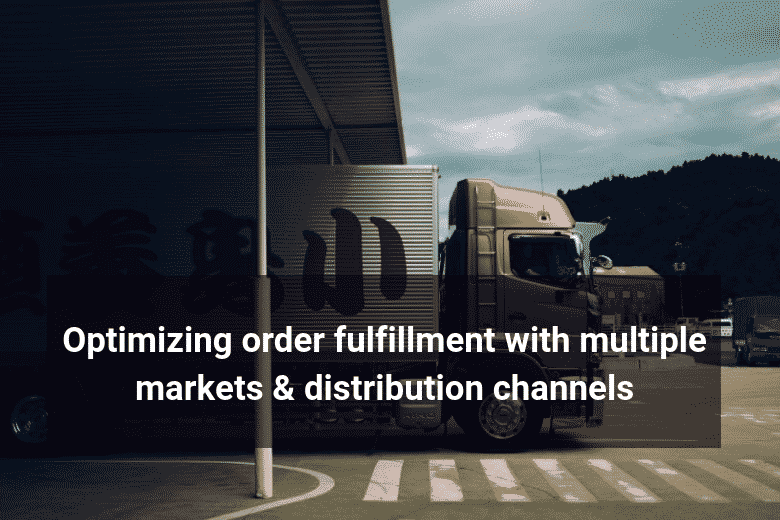Whether you sell on Amazon or run your own eCommerce store, there are pros and cons to your strategy. While Amazon gives you the reach, it also pits your product against dozens of competitors that your prospective buyers may switch to. Owning your own online store gives you absolute control over your website, but also requires you to compete against big guns like Amazon and Best Buy.
Multichannel fulfillment may seem ideal in such cases since you draw in customers through Amazon and nudge them over time to engage directly over your own online store. Multichannel fulfillment is also a necessity today since a significant number of orders come in via social media platforms like Facebook.
Challenges with multichannel fulfillment
While selling your products over multiple channels may seem very attractive to begin with, it is not without its share of challenges. One of the most serious challenges here is with respect to inventory management. Ideally, you will have one warehouse to handle orders from all your various distribution channels.
But it does not always work that way. Amazon sellers who opt for FBA will need to hold a part of their inventory in Amazon’s warehouse. However, this holds up your inventory for other channels. Although it is technically possible to hold all your inventory on Amazon itself, it increases your holding costs significantly. You may hence want to stock your products in a low cost, free trade zone like Hong Kong.
Also, if you dropship a part or all of your inventory, you may also need to rely on your supplier to handle shipping of those particular orders.
Identifying the right warehousing strategy
Very few businesses choose to own their warehouses. Third party fulfillment centers play a vital role in ensuring seamless logistics and order management.
The first step in the process is to identify the right warehousing location. This depends on several factors – the location of your manufacturer, where your customers are located, the shipping time, number of distribution channels, and return policies.
For instance, if you sell sports jerseys, your customers are likely to be concentrated in specific cities where a sports team is based out of. An ‘LA Lakers’ jersey is likely to be more popular in Los Angeles than in any other part of the US or elsewhere. In such instances, it is logical to hold your inventory close to your market.
But more often than not, your customers tend to be located all over a country or even the world. Having separate warehouses in each of your markets can be expensive. Also, holding costs in western countries like the US or UK can be a lot more expensive than holding your goods in Asia. In such instances, a good strategy is to hold your inventory close to the supplier and ship products on demand.
For instance, if your products are manufactured in China, then holding your inventory in Hong Kong can be quite effective. Warehousing costs in Hong Kong a lot less expensive than they are in the United States. Also, Hong Kong is a free trade zone and shipping from here to other parts of the world can be cheaper than alternate warehousing destinations.

This is all the more critical for multichannel fulfillment. Holding inventory close to your market introduces multiple variables that can become too hard to manage.
For instance, let us assume that your business operates two warehouses in the US and the UK. If your products go out of stock in the UK, you may be required to ship them either from your manufacturing center (that takes time) or ship them quick from the US.
The latter strategy could wipe your margins significantly due to higher shipping costs. In a multichannel fulfillment scenario, this is further complicated by the need to predict demand from each of your various channels in addition to just the location.
By holding inventory in just one location close to the manufacturer, you could ship products on demand to multiple destinations and via multiple channels much more predictable and efficiently.
Multichannel fulfillment with multiple suppliers
Now consider a typical multichannel fulfillment scenario where you deal with multiple markets as well as suppliers. If your suppliers are located in different countries, then you may be required to hold inventories close to each of your suppliers. But this is not ideal since if your market for one product is close to the supplier of another product, you may want to optimize costs by stocking products close to the market rather than the manufacturer.
There are a number of warehouse optimization applications online that you could invest in to make the job simpler for you. If you sell commodity products, you could also minimize your challenges by opting for selective dropshipping of products. ECommerce platforms like Shopify have their own dropshipping services like Oberlo where you can find verified suppliers for your business. By dropshipping your non-core products, you may be able to optimize inventory and warehousing location for your core SKUs.
Although optimization is difficult under such circumstances, many businesses choose to have warehouses close to their markets in such cases. This is because of a couple of reasons.
Firstly, this minimizes the distance that your product has to travel before reaching its destination. More importantly, it is helpful to offer competitive return policies to customers when the warehouse is close to the buyers.
The challenge does not get exacerbated due to multichannel fulfillment. This is because regardless of how many channels you sell your products on, your markets are fairly the same. Having your products close to the market in such circumstances makes sense.
However, this does contribute to higher operational costs. This strategy requires businesses to have a larger buffer of inventory across each of their warehouses (since an order in one market cannot be fulfilled by the product that is stocked in a warehouse close to another market). This results in what is known as the “bullwhip effect”, an inefficiency caused by improper demand forecasting at each level of the supply chain.
In conclusion, optimizing your warehouse is not easy and this challenge is only made complicated with multiple sellers, markets and distribution channels. However, the strategies provided in this article should help a seller factor in the challenges and solutions available before they go with the best solution for their business.
Author Bio
Benjamin S Powell is the founder of AdSoup, a social CRM app that brings customer conversations from Facebook, email, Whatsapp, SMS, Twitter and LINE into one unified inbox.

Ready To Upgrade Your Logistic Solution?
Speak to Floship ecommerce logistic consultant about improving your global support chain today





